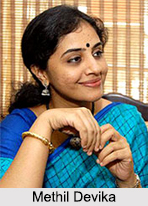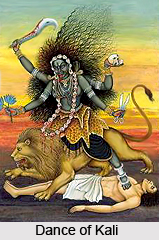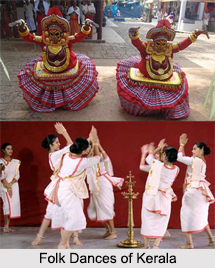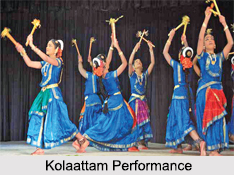Introduction
Kathakali Dance performance is a major social event. They generally start at dusk and go throughout the night. Kathakali is usually performed only by men. Female characters are portrayed by men dressed in women’s costume. However, in recent years, women are also sharing the stage as Kathakali dancers. Kathakali performance mostly takes place on a temple premises or at the house of a local landlord. The Kathakali tradition dates back to the 17th century.
Like all other dance forms Kathakali has also undergone changes over the time. In Kathakali emphasis is given more on "Aharya Abhinaya", the use of costumes, ornaments and facial make-up. It is interesting to note that Kathakali is the only Indian dance form in which the entire body, both skeleton and muscles, down to even the smallest facial muscle are used to portray emotion. When Kathakali dance is being performed the text of the drama or the story is sung for the dancer and is the baseline for his or her interpretation.
Stage for Kathakali Dance Performance
For a typical performance, a simple temporary pandal at a height of 10 and 1/2 feet is erected. A minimum of 144 sqft stage is needed for the acting area. A green room is also located close to the stage. The stage is decorated with coconut leaves, bunches of areca nuts etc. The only source of light is a big bell metal lamp placed down the center stage. The level of the stage used to be the same as that of the ground where people used to squat while witnessing the performance.
Kathakali Dance Performance
A Kathakali performance begins with the "Kelikottu", calling the audience to attention followed by the "Thodayam". Kelikottu will announce the performance of the evening at about 6 pm. The actual performance will begin only between 9-10 pm. It is a devotional number performed where one or two characters invoke the blessings of the gods. Junior actors in the group with simple make-up and perform Thodayam. "Kelikottu" is the formal announcement of the performance done in the evening when drums and cymbals are played for a while in the courtyard. Recitation of "Vandanaslokam" (Prayer Song) followed by "Purappad" - traditionally a preliminary item introducing the main character of the story in full costume and make-up. However, nowadays it is mostly "Krishna" and "Balarama" who are presented, sometime with their spouses in this introductory dance.
A pure dance piece known as the "Purappad" comes as a sequel to this. Then the musicians and drummers hold the stage entertaining the audience with an exhibition of their skills in "Melappadam". Then the story or parts of the stories proposed are enacted which may last till dawn. The end of the performance is marked by a piece of pure dance called "Dhanasi". Drummers, singers, make-up artists and costumers complete the ensemble of highly trained specialists, to present a Kathakali performance. "Tiranokku" is the debut on the stage of all characters other than the "Pacha" or "Minukku". Thereafter, the play or the particular scene of the chosen play begins.
The orchestra which is also used in other traditional performing arts of Kerala normally comprises the Chenda, Maddalam, Chengila, Elathalam, Idakka and Shankhu.
Repertoire in Kathakali Performance
Kathakali revolves around performances called Attakatha
(literally, “enacted story”). These plays, composed in a blend of Sanskrit and Malayalam, are meticulously
structured to distinguish between the narrative and dialogue elements. The
Sloka sections, often in Sanskrit, serve as metrical verses that describe the
unfolding action, while the Pada portions carry the spoken dialogues. This
well-defined format not only aids storytelling but also provides performers
with the creative liberty to improvise. The themes of Attakatha are deeply
rooted in Hindu epics and
scriptures, predominantly drawing inspiration from the Ramayana, Mahabharata, and Bhagavata Purana.
A traditional Kathakali performance is an elaborate, operatic presentation that unfolds over several hours, often lasting from dusk till dawn. Historically, some plays stretched across multiple nights, resuming each evening. While modern adaptations have condensed the duration, the essence of the storytelling remains intact. The performance typically takes place in open courtyards adjacent to temples, though dedicated theatres called Kuttampalam, found within temple complexes, have long been used for such artistic expressions.
The stage setup in Kathakali is minimalist, featuring only
essential props. A significant element is the Kalivilakku, a large ceremonial
lamp with a thick wick burning in coconut oil. This lamp, a legacy from the
Kutiyattam tradition, serves as the primary light source, casting a warm glow
on the performers. Before the advent of electricity, this was the only means of
illumination, and dancers would skillfully position themselves around it to
ensure their elaborate facial expressions and gestures were visible to the
audience.
The performance structure consists of actor-dancers at the forefront, accompanied by musicians positioned toward the right of the stage (from the audience’s perspective). Vocalists, once placed at the front to project their voices effectively, continue to hold a prominent role in shaping the emotional depth of the narrative. Traditionally, all roles in Kathakali were performed by men, even female characters. However, contemporary adaptations have welcomed women into the art form, enriching its diversity while preserving its rich heritage.
Kathakali remains a mesmerizing blend of dance, drama, and
music, encapsulating India’s storytelling traditions through its visually
striking and deeply expressive performances.
Acting in Kathakali
Kathakali is a unique blend of choreography and acting, demanding years of rigorous training before performers step onto the stage. Considered one of the most challenging classical art forms, it requires exceptional control over facial expressions, hand gestures, and body movements.
A distinctive feature of Kathakali is its "sign
language," where dialogues are conveyed through intricate hand gestures
known as mudras, while emotions and moods are expressed through highly refined
facial and eye movements. This silent yet powerful communication system enables
the actors to bring characters to life without spoken words.
Supporting this visual storytelling, vocalists in the background sing the narrative in rhythmic synchrony with the orchestra, creating a harmonious fusion of movement, music, and expression. The coordination between the dancers, singers, and musicians ensures a seamless performance, immersing the audience in the dramatic retelling of mythological tales.
The demanding nature of Kathakali requires intense physical
and emotional discipline, with performers dedicating years to mastering every
nuance. This synergy of acting, dance, and music transforms Kathakali into a
mesmerizing theatrical experience, where every gesture and expression resonates
with profound storytelling depth.
Music in Kathakali Performance
Music plays a vital role in Kathakali, shaping the mood, enhancing emotions, and guiding the rhythm of the performance. It not only complements the storytelling but also synchronizes with the choreography, ensuring a seamless blend of movement and melody. Different musical patterns are used to evoke specific emotions and intensify dramatic moments on stage.
Among the most commonly used rhythms is Chempada, which serves as the default beat for various moods, including battle sequences and climactic conclusions. Chempa conveys tension, often used in moments of disagreement or conflict. Panchari sets the tone for preparatory scenes, such as sharpening a sword, while Triputa creates a contemplative atmosphere, ideal for philosophical discussions involving sages and teachers. Scenes featuring royalty or divine beings are accompanied by Adantha, whereas Muri Adantha is reserved for lighthearted, comic, or high-energy sequences driven by heroism or anger.
Kathakali’s musical ensemble features a variety of
percussion instruments, with three primary drums forming the backbone of the
rhythm. The Maddalam, a barrel-shaped drum, provides deep, resonant beats. The
Chenda, a cylindrical drum played with curved sticks, adds intensity, while the
Idakka, an hourglass-shaped drum, produces softer, melodic tones, particularly
during scenes featuring female characters.
Training of Kathakali Performance
Kathakali training is an intense and highly disciplined process, requiring years of dedicated practice before a performer can debut on stage. The training follows a structured and codified system, focusing on physical endurance, intricate facial expressions, and precise hand gestures.
Influences from other classical art forms, such as Kalaripayattu and Koodiyattam, play a significant role in Kathakali’s training methodology. The martial art Kalaripayattu contributes to the dynamic body movements and athletic agility required for Kathakali, while Koodiyattam provides a foundation for expressive gestures and intricate facial expressions that bring characters to life.
The rigorous training process not only develops physical and artistic skills but also instills discipline and devotion, essential for mastering this demanding art. With its deep-rooted traditions and evolving inclusivity, Kathakali continues to be a powerful and mesmerizing storytelling medium, preserving its cultural heritage while embracing contemporary influences.




